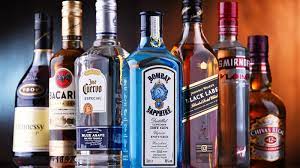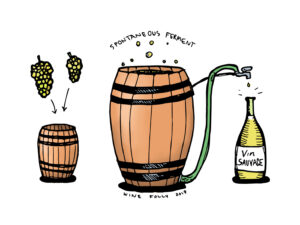Back to: Catering Craft SS 3
Welcome to today’s class!!
We are thrilled to have you in our class!!
In today’s Catering Craft’s class, we will be learning about Alcoholic Beverages
Alcoholic Beverages
While we learned that Beverages are any drink other than water, we discovered that beverages could either be Alcoholic or non-alcoholic.
Now, let’s look at Alcoholic Beverages.
Alcoholic beverages are fermented from the sugars in fruits, berries, grains, and such other ingredients as plant saps, tubers, honey, and milk and may be distilled to reduce the original watery liquid to a liquid of much greater alcoholic strength.

Beer is the best-known member of the malt family of alcoholic beverages, which also includes ale, stout, porter, and malt liquor. It is made from malt, corn, rice, and hops.
Beers range in alcoholic content from about 2 percent to about 8 percent.
Wine is made by fermenting the juices of grapes or other fruits such as apples (cider), cherries, berries, or plums.

Winemaking begins with the harvest of the fruit, the juice of which is fermented in large vats under rigorous temperature control. When fermentation is complete, the mixture is filtered, aged, and bottled. Natural, or unfortified, grape wines generally contain from 8 to 14 percent alcohol; these include such wines as Bordeaux, Burgundy, Chianti, and Sauterne. Fortified wines, to which alcohol or brandy has been added, contain 18 to 21 percent alcohol; such wines include sherry, port, and muscatel.
In the ingestion of an alcoholic beverage, the alcohol is rapidly absorbed in the gastrointestinal tract (stomach and intestines) because it does not undergo any digestive processes; thus, alcohol rises to high levels in the blood in a relatively short time. From the blood the alcohol is distributed to all parts of the body and has an especially pronounced effect on the brain, on which it exerts a depressant action. Under the influence of alcohol the functions of the brain are depressed in a characteristic pattern.
According to studies, the most complex actions of the brain—judgment, ability to criticize, the inhibitions learned from earliest childhood—are depressed first, and the loss of this control results in a feeling of excitement in the early stages. For this reason, alcohol is sometimes thought of as a stimulant.
Alcohol consumption is not a license for being drunk, it is meant to be taken respectfully.
In summary, under the influence of increasing amounts of alcohol, the drinker gradually becomes less alert, awareness of his environment becomes dim and hazy, muscular coordination deteriorates, and sleep is facilitated, which is why the acceptable age for alcohol consumption is age 18 and above.
Evaluation
What are Alcoholic Beverages?
Reading Assignment
List two two days between Alcoholic and Non-alcoholic Beverages.
Weekend Assignment
Explain five medical implications of consuming alcohol.
We hope you enjoyed today’s class. In our next class, we will be talking about Test Interpretation of Food And Beverages.
Let us know your thoughts and questions in the comment section, and we will attend to them as fast as we can.
